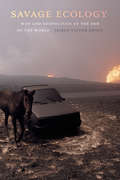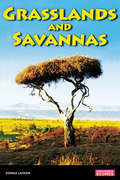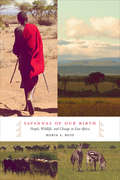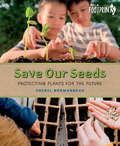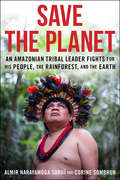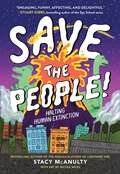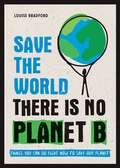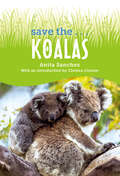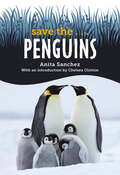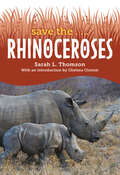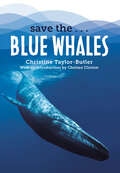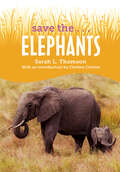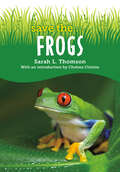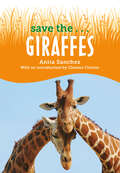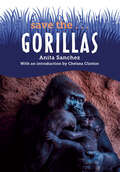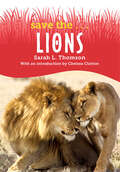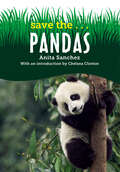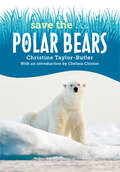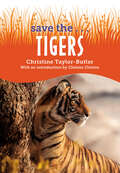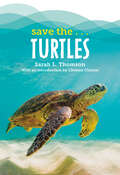- Table View
- List View
Savage Ecology: War and Geopolitics at the End of the World
by Jairus Victor GroveJairus Victor Grove contends that we live in a world made by war. In Savage Ecology he offers an ecological theory of geopolitics that argues that contemporary global crises are better understood when considered within the larger history of international politics. Infusing international relations with the theoretical interventions of fields ranging from new materialism to political theory, Grove shows how political violence is the principal force behind climate change, mass extinction, slavery, genocide, extractive capitalism, and other catastrophes. Grove analyzes a variety of subjects—from improvised explosive devices and drones to artificial intelligence and brain science—to outline how geopolitics is the violent pursuit of a way of living that comes at the expense of others. Pointing out that much of the damage being done to the earth and its inhabitants stems from colonialism, Grove suggests that the Anthropocene may be better described by the term Eurocene. The key to changing the planet's trajectory, Grove proposes, begins by acknowledging both the earth-shaping force of geopolitical violence and the demands apocalypses make for fashioning new ways of living.
Savage Tsunamis
by Michael PortmanIntroduces tsunamis, describing how they are formed, the damages that result from them, and the devices that are being developed to predict them.
Savannas and Grasslands
by Donna LathamInvestigating a variety of biomes and today's natural and human threats to their preservation, this interactive series challenges young readers to look at how their own actions influence the planet's health. Four distinct environments are explored in detail, showcasing the assortment of plants and animals that inhabit these outdoor communities as well as how they have adapted to their surroundings. Offering fascinating facts on each ecosystem along with vocabulary-building sidebars, these guides show budding scientists how they can contribute towards ongoing conservation efforts. Exploring the vast biome of the savannas and grasslands, this reference highlights the problems of disease and invasive species, outlining how this beautiful setting across the world can be saved.
Savannas of Our Birth
by Robin S. ReidThis book tells the sweeping story of the role that East African savannas played in human evolution, how people, livestock, and wildlife interact in the region today, and how these relationships might shift as the climate warms, the world globalizes, and human populations grow. Our ancient human ancestors were nurtured by African savannas, which today support pastoral peoples and the last remnants of great Pleistocene herds of large mammals. Why has this wildlife thrived best where they live side-by-side with humans? Ecologist Robin S. Reid delves into the evidence to find that herding is often compatible with wildlife, and that pastoral land use sometimes enriches savanna landscapes and encourages biodiversity. Her balanced, scientific, and accessible examination of the current state of the relationships among the region's wildlife and people holds critical lessons for the future of conservation around the world.
Save Our Seeds: Protecting Plants for the Future (Orca Footprints #31)
by Sheryl NormandeauKey Selling Points Learning about the importance of seeds and how to save and conserve them for the future is imperative to sustaining healthy life on the planet. Introduces young readers to STEM concepts, such as pollination, biodiversity, healthy ecosystems, food security, the climate crisis, GMO food and genetic engineering. Gives young readers the practical tools to take action to save seeds in their own lives and communities. The author is a certified master gardener and works with various gardening organizations in Alberta. She has a background in horticulture and urban agriculture and has written a number of nonfiction books for adults and kids.
Save The Planet: An Amazonian Tribal Leader Fights for His People, The Rainforest, and The Earth
by Corine Sombrun Julia Grawemeyer Almir Narayamoga SuruiAlmir Sarayamoga Suruí, the Amazonian tribal chieftain of the indigenous Suruí people, is a leader in the fight to save the rainforest not only for the preservation of his land and people, but for the Earth's and humanity's survival as well. Joining forces with such high-tech corporations as Apple and Google Earth, Suruí has become a guardian of his people and a global activist, despite death threats and million dollar bounties on his head. A recipient of the Global Citizen Award in 2012, Suruí has calculated the direct cost of the loss of our rainforests—"the lungs of the Earth"—in terms of the total amount of Co2 that their destruction would release into the atmosphere, and the monetary loss that this would entail, and by using this carbon deficit formula, has leased access to pharmaceutical and cosmetic companies who have joined him in the stewardship of these endangered lands, their flora, fauna, and people.
Save the Animals! (Saving Our Planet)
by Mary BooneIntroduces early readers to environmentalist concepts including deforestation, animals and their habitats, and conservation, and what they can do to help the environment. Features real-life examples of kids who have made a difference.
Save the Florida Key Deer
by Margaret Goff ClarkThe tiny Florida Key deer need protection. The little deer of the Florida Keys are found nowhere else in the world. Related to the white-tailed deer, the Key deer is not much larger than a big dog. Today, it is an endangered species. There are no more than a few hundred left. The little deer wander through backyards and front lawns. Reduced speed limits are posted, but many deer get killed by automobiles. It is against the law to feed them. That makes them lose their natural fear of people and cars, and more likely to get killed. The National Key Deer Refuge was established on Big Pine Key in 1957, but more land is needed. People who live on the Keys like the little animals, and efforts are being made to find room for building developments and also enough space for Key deer to thrive.
Save the People!: Halting Human Extinction
by Stacy McAnulty"Save the People is engaging, funny, affecting and delightful. You&’ll never have more fun learning science." --Stuart Gibbs, bestselling author of the Spy School series "Serious science and great gags, with a bit of hope thrown in.&” --Steven Sheinkin, bestselling author of Bomb and FalloutAn action-packed look at past, present, and future threats to humanity&’s survival—with an ultimately reassuring message that humans probably have a few more millennia in us.Scientists estimate that 99% of all species that have ever existed are now extinct. Whoa. So, it's not unreasonable to predict humans are doomed to become fossil records as well. But what could lead to our demise? Supervolcanos? Asteroids? The sun going dark? Climate change? All the above?! Humans—with our big brains, opposable thumbs, and speedy Wi-Fi—may be capable of avoiding most of these nightmares. (The T. rex would be super jealous of our satellites.) But we're also capable of triggering world-ending events. Learning from past catastrophes may be the best way to avoid future disasters. Packed with science, jokes, and black and white illustrations, Save the People! examines the worst-case scenarios that could (but hopefully won&’t) cause the greatest mass extinction—our own!
Save the Seas: Join the Green Team and find out why our seas and oceans need protecting
by Liz GogerlyFind out about our seas and oceans with the green team, Anjali, Lulu, Mason and NoahThe four friends are having fun on the beach when they spot lots of plastic waste scattered everywhere. Discarded drinks bottles, straws, an old flipflop and even a toothbrush! How did it all get here? The children decide to investigate and soon learn all about seas and oceans, from tides and tidal waves to food chains and climate change. Full of fascinating facts and fun activities, this book will tell you everything you've ever wanted to know about our amazing seas and oceans and what you can do to help protect them!Throughout this book, there are Take Action advice panels, which give examples of small ways that people can get involved to help protect our seas and oceans.Get Busy activity suggestions encourage children to be actively engaged in conservation issues.There are also full-page, step-by-step activities for how to make the layers of the ocean or how to make a surf board float.By the end of the book, readers will have a better understanding of the importance of our seas and oceans, humans' impact on them and what can be done to help protect themLook out for the other titles in this series: Go Green!, Wild Weather! and Nature Needs You!
Save the World: There is No Planet B: Things You Can Do Right Now to Save Our Planet
by Louise BradfordTogether, we can change the worldThere is little doubt that our beautiful planet is now under huge threat; our weather is more extreme, plastic litters our oceans, industrial production and farming methods wreak havoc on the environment and mass deforestation has led to the extinction of many species. Carry on this way and it’s almost certain that sea levels will continue to rise, there will be extreme heatwaves, loss of the polar ice caps and mass pollution; in short, a very worrying future for us all. We need to take action before it’s too late, and we can all do our bit to help. This guide is full of simple tips we can all incorporate into our daily lives, and will demonstrate how small eco-friendly changes can have a huge positive effect on the world around us. They might even save the planet.
Save the World: There is No Planet B: Things You Can Do Right Now to Save Our Planet
by Louise BradfordTogether, we can change the worldThere is little doubt that our beautiful planet is now under huge threat; our weather is more extreme, plastic litters our oceans, industrial production and farming methods wreak havoc on the environment and mass deforestation has led to the extinction of many species. Carry on this way and it’s almost certain that sea levels will continue to rise, there will be extreme heatwaves, loss of the polar ice caps and mass pollution; in short, a very worrying future for us all. We need to take action before it’s too late, and we can all do our bit to help. This guide is full of simple tips we can all incorporate into our daily lives, and will demonstrate how small eco-friendly changes can have a huge positive effect on the world around us. They might even save the planet.
Save the... Koalas (Save the...)
by Chelsea Clinton Anita SanchezKoalas have climbed and munched their ways into kids' hearts. With this book, readers can become koala experts and learn how to save the animals they love. Featuring an introduction from Chelsea Clinton!Did you know that koalas spend most of their lives up in the treetops, only coming down if they run out of leaves to munch on? How about that koalas eat almost every minute that they're awake? Or that these cute and cuddly looking animals can give off earsplitting roars that can be heard half a mile away?Perfect for all animal lovers—and koala fans in particular—this book is filled with all the facts you need to know to become a koala expert! Where are koalas found? What's it like to be a koala? Why are koalas endangered, and who has been working hard to save them? Read this book and find out how you can help save the koalas!Complete with black-and-white photographs, a list of fun koala facts, and things that kids can do right this very moment to help save koalas from extinction, this book, with an introduction by animal advocate Chelsea Clinton, is a must for every family, school, and community library.
Save the... Penguins (Save the...)
by Chelsea Clinton Anita SanchezPenguins have marched and waddled their ways into kids' hearts. With this book, readers can become penguin experts and learn how to save the animals they love. Featuring an introduction from Chelsea Clinton!Did you know that penguins are the fastest-swimming birds on the planet? How about that their tuxedo-like coloring actually helps them keep their bodies at just the right temperature? Or that the biggest penguins of all, Emperor penguins, can dive deep into the water, holding their breath for almost half an hour? Perfect for all animal lovers—and penguin fans in particular—this book is filled with all the facts you need to know to become a penguin expert! Where are penguins found? What's it like to be a penguin? Why are penguins endangered, and who has been working hard to save them? Read this book and find out how you can help save the penguins!Complete with black-and-white photographs, a list of fun penguin facts, and things that kids can do right this very moment to help save penguins from extinction, this book, with an introduction by animal advocate Chelsea Clinton, is a must for every family, school, and community library.
Save the... Rhinoceroses (Save the...)
by Sarah L. Thomson Chelsea ClintonRhinoceroses have wallowed and grazed their ways into kids' hearts. With this book, readers can become rhinoceros experts and learn how to save the animals they love. Featuring an introduction from Chelsea Clinton!Did you know that rhinoceroses are the second biggest land animal in the world, second only to elephants? How about that rhinos have especially poor eyesight? Or that white and black rhinos are called that even though neither of them is black or white?Perfect for all animal lovers—and rhino fans in particular—this book is filled with all the facts you need to know to become a rhinoceros expert! Where are rhinos found? What's it like to be a rhino? Why are rhinos endangered, and who has been working hard to save them? Read this book and find out how you can help save the rhinoceroses!Complete with black-and-white photographs, a list of fun rhino facts, and things that kids can do right this very moment to help save rhinoceroses from extinction, this book, with an introduction by animal advocate Chelsea Clinton, is a must for every family, school, and community library.
Save the...Blue Whales (Save the...)
by Christine Taylor-Butler Chelsea ClintonBlue whales have swum and sprayed their ways into kids' hearts. With this book, readers can become blue whale experts and learn how to save the animals they love. Featuring an introduction from Chelsea Clinton! <P><P> Did you know that the tongue of blue whale can weigh as much as an elephant? How about that blue whales’ songs can be louder than the engine of a jet plane? Or that, with the right equipment, you can hear a blue whale’s heartbeat two miles away? <P><P> Perfect for all animal lovers—and blue whale fans in particular—this book is filled with all the facts you need to know to become a blue whale expert! Where are blue whales found? What's it like to be a blue whale? Why are blue whales endangered, and who has been working hard to save them? Read this book and find out how you can help save the blue whales! <P><P> Complete with black-and-white photographs, a list of fun blue whale facts, and things that kids can do right this very moment to help save blue whales from extinction, this book, with an introduction by animal advocate Chelsea Clinton, is a must for every family, school, and community library.
Save the...Elephants (Save the...)
by Sarah L. Thomson Chelsea ClintonElephants have roamed and trumpeted their ways into kids' hearts. With this book, readers can become elephant experts and learn how to save the animals they love. Featuring an introduction from Chelsea Clinton!Did you know that elephants can't jump? How about that no two elephants have ears that are exactly alike? Or that elephants all walk on tiptoe?Perfect for all animal lovers--and elephant fans in particular--this book is filled with information that young readers will love to learn. From where elephant habitats are found to what it's like to be an elephant to why elephants are endangered and who has been working hard to save them, this book gives readers all the facts they know to become elephant experts.Complete with black-and-white photographs, a list of fun elephant facts, and things that kids can do right this very moment to help save elephants from extinction, this book, with an introduction by animal advocate Chelsea Clinton, is a must for every family, school, and community library.
Save the...Frogs (Save the...)
by Sarah L. Thomson Chelsea ClintonFrogs have hopped and croaked their ways into kids' hearts. With this book, readers can become frog experts and learn how to save the animals they love. Featuring an introduction from Chelsea Clinton!Did you know that some frogs can leap twenty times the length of their own bodies? How about that the largest frog in the world weighs more than a chihuahua? Or that frogs drink through their skin and not through their mouths?Perfect for all animal lovers—and frog fans in particular—this book is filled with all the facts you need to know to become a frog expert! Where are frogs found? What's it like to be a frog? Why are frogs endangered, and who has been working hard to save them? Read this book and find out how you can help save the frogs!Complete with black-and-white photographs, a list of fun frog facts, and things that kids can do right this very moment to help save frogs from extinction, this book, with an introduction by animal advocate Chelsea Clinton, is a must for every family, school, and community library.
Save the...Giraffes (Save the...)
by Chelsea Clinton Anita SanchezGiraffes have stretched and munched their ways into kids' hearts. With this book, readers can become giraffe experts and learn how to save the animals they love. Featuring an introduction from Chelsea Clinton!Did you know that one well-placed giraffe kick is strong enough to kill a lion? How about that an adult giraffe can eat a hundred pounds of leaves in a day? Or that some giraffes hum to each other at night?Perfect for all animal lovers—and giraffe fans in particular—this book is filled with all the facts you need to know to become a giraffe expert! Where are giraffes found? What's it like to be a giraffe? Why are giraffes endangered, and who has been working hard to save them? Read this book and find out how you can help save the giraffes!Complete with black-and-white photographs, a list of fun giraffe facts, and things that kids can do right this very moment to help save giraffes from extinction, this book, with an introduction by animal advocate Chelsea Clinton, is a must for every family, school, and community library.
Save the...Gorillas (Save the...)
by Chelsea Clinton Anita SanchezGorillas have knuckle-walked their ways into kids' hearts. With this book, readers can become gorilla experts and learn how to save the animals they love. Featuring an introduction from Chelsea Clinton!Did you know that gorillas&’ massive arms are strong enough to tear down trees and bend iron bars? How about that, even so, gorillas can be tender friends and gentle, loving parents? Or that gorillas are ticklish?Perfect for all animal lovers—and gorilla fans in particular—this book is filled with all the facts you need to know to become a gorilla expert! What's it like to be a gorilla? Why are gorillas endangered, and who has been working hard to save them? Read this book and find out how you can help save the gorillas!Complete with black-and-white photographs, a list of fun gorilla facts, and things that kids can do right this very moment to help save gorillas from extinction, this book, with an introduction by animal advocate Chelsea Clinton, is a must for every family, school, and community library.
Save the...Lions (Save the...)
by Sarah L. Thomson Chelsea ClintonLions have roared and pounced their ways into kids' hearts. With this book, readers can become lion experts and learn how to save the animals they love. Featuring an introduction from Chelsea Clinton!Did you know that a lion can eat hundreds of pounds of meat at a time, as much as is found in four hundred hamburgers? How about that lions are the only kind of cat that lives, hunts, and eats in a group? Or that a lion's roar can be heard up to five miles away?Perfect for all animal lovers—and lion fans in particular—this book is filled with all the facts you need to know to become a lion expert! Where are lions found? What's it like to be a lion? Why are lions endangered, and who has been working hard to save them? Read this book and find out how you can help save the lions!Complete with black-and-white photographs, a list of fun lion facts, and things that kids can do right this very moment to help save lions from extinction, this book, with an introduction by animal advocate Chelsea Clinton, is a must for every family, school, and community library.
Save the...Pandas (Save the...)
by Chelsea Clinton Anita SanchezPandas have rolled and munched their ways into kids' hearts. With this book, readers can become panda experts and learn how to save the animals they love. Featuring an introduction from Chelsea Clinton!Did you know that pandas only live in the wild in China? How about that they are the only species of bear that eats almost nothing but plants? Or that pandas' black and white fur helps them hide in the shadows of their bamboo forests? Perfect for all animal lovers—and panda fans in particular—this book is filled with all the facts you need to know to become a panda expert! Where are pandas found? What's it like to be a panda? Why are pandas endangered, and who has been working hard to save them? Read this book and find out how you can help save the pandas!Complete with black-and-white photographs, a list of fun panda facts, and things that kids can do right this very moment to help save pandas from extinction, this book, with an introduction by animal advocate Chelsea Clinton, is a must for every family, school, and community library.
Save the...Polar Bears (Save the...)
by Christine Taylor-Butler Chelsea ClintonPolar bears have swum and lumbered their ways into kids' hearts. With this book, readers can become polar bear experts and learn how to save the animals they love. Featuring an introduction from Chelsea Clinton!Did you know that a polar bear's fur looks white only because it reflects the light around it, and that its skin is jet-black underneath? How about that a polar bear can swim constantly for days at a time? Or that male polar bears can weigh as much as ten men?Perfect for all animal lovers—and polar bear fans in particular—this book is filled with all the facts you need to know to become a polar bear expert! Where are polar bears found? What's it like to be a polar bear? Why are polar bears endangered, and who has been working hard to save them? Read this book and find out how you can help save the polar bears!Complete with black-and-white photographs, a list of fun polar bear facts, and things that kids can do right this very moment to help save polar bears from extinction, this book, with an introduction by animal advocate Chelsea Clinton, is a must for every family, school, and community library.
Save the...Tigers (Save the...)
by Christine Taylor-Butler Chelsea ClintonTigers have roared and pounced their ways into kids' hearts. With this book, readers can become tiger experts and learn how to save the animals they love. Featuring an introduction from Chelsea Clinton!Did you know that a tiger roar can be heard from two miles away? Or that tiger saliva prevents infection? Or how about that a tiger's urine smells like buttered popcorn? Perfect for all animal lovers--and tiger fans in particular--this book is filled with information that young readers will love to learn. From where tiger habitats are found to what it's like to be a tiger to why tigers are endangered and who has been working hard to save them, this gives readers all the facts they know to become tiger experts.Complete with black-and-white photographs, a list of fun tiger facts, and things that kids can do right this very moment to help save tigers from extinction, this book, with an introduction by animal advocate Chelsea Clinton, is a must for every family, school, and community library.
Save the...Turtles (Save the...)
by Sarah L. Thomson Chelsea ClintonTurtles have swum and snapped their ways into kids' hearts. With this book, readers can become turtle experts and learn how to save the animals they love. Featuring an introduction from Chelsea Clinton!Did you know that a turtle named Jonathan is the oldest known living animal on Earth? (He&’s almost two hundred!) How about that the largest sea turtles can dive more than three thousand feet below the water&’s surface? Or that turtles&’ shells have a spine in them, which makes turtles vertebrates—just like humans?Perfect for all animal lovers—and turtle fans in particular—this book is filled with all the facts you need to know to become a turtle expert! Where are turtles found? What&’s it like to be a turtle? Why are turtles endangered, and who has been working hard to save them? Read this book and find out how you can help save the turtles!Complete with black-and-white photographs, a list of fun turtle facts, and things that kids can do right this very moment to help save turtles from extinction, this book, with an introduction by animal advocate Chelsea Clinton, is a must for every family, school, and community library.
